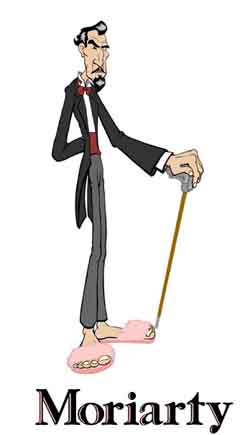Hey, everyone. “Moriarty” here. A hotel on a side street a few blocks from where the main Tower Records on Sunset used to be. Mid-morning, but early for me, especially since I’m driving in from Northridge to do these things now. I’m one of a series of people to sit down for a few minutes with a director I hadn’t heard of before two months ago, a filmmaker who may very well have landed a film on my ten best list already. I’m excited to be meeting him, and I hope this is just the first of many films of his that are worth discussion in years to come. Be warned. We touch on a few spoilers, including one point that is ambiguous in the movie, but which he makes explicit in conversation: Moriarty: Just got back in from Austin, where I saw the film the first time at Fantastic Fest, and I’ve seen it again now. I think it’s exceptional.
Tomas Alfredson: Really? Thank you.
Moriarty: You have a knack for directing children, and it’s one of those skill sets I think a director either has, or never will. The kids you found are remarkable. Can you talk about the process of getting these wise adult performances out of them?
Tomas Alfredson: Yeah... those two kids are... it took nearly a year to find them. We don’t really have professional children actors in Sweden, so we had to have open castings to find... to find children. And my instinct is that if kids actors are too good or too polished, or if they’ve been trained too much, it won’t work on film. You have to have some sort of natural spirit to do good film acting. This was also complicated, because I had to find a couple. Not just one plus one. It had to be a couple. My thought is that, uh, they are the same character. Two sides of the same character. They are mirrors of each other, these two children. He’s bright, she’s dark. She’s strong, he’s weak. And so on. So they had to be each other’s... uh... what do you say?
Moriarty: Opposites.
Tomas Alfredson: Yes. Opposites. So that was quite complicated, and then, ummm... there’s this thing that Eli is... a former boy. It’s a boy from the beginning. So that person would have to be a little... androgyne? How do you say?
Moriarty: Androgynous.
Tomas Alfredson: Androgynous.
Moriarty: It’s interesting that you treat that almost as subtext in the movie. Talking to people after seeing it, there was a lot of disagreement about what that meant and whether we were picking up the right things.
Tomas Alfredson: Yeah. He was castrated almost 100 years ago. That’s the backstory.
Moriarty: That makes sense.
Tomas Alfredson: There was a scene where we had bits and pieces of it, but it let out too much of the backstory to show that. So now it’s just the one quick glimpse of Eli’s genitals or non-genitals.
Moriarty: We always hear that America is where we have the school shootings or school violence, or kids who just emotionally implode for whatever reason. But watching this, I get the feeling that Oskar is close. That the bullying has been so constant and so extreme that he’s very close to becoming a monster himself. Then he meets this “real” monster who pulls him back from the edge. So there’s something to the film, about the idea of feeling powerless in the world. Did you approach this as a horror film, or is the genre incidental?
Tomas Alfredson: For me, it’s the love story. This is a love story with horror elements woven into it. And look, there are lots of stories about the bullied boy or the bullied girl getting tormented in school or wherever, and they are like... they become like Jesus. They are very proud, very clean, very stoic. They sit somewhere in the evening and they cry. But my belief is that if you are bullied, you get very, very angry. So to me, the character is... she is his anger in the shape of a person. And I would think he would be a very dangerous person, this Oskar, in the future. Or in the near future, if he doesn’t find a way through this. So... it’s quite simple. If you give love to a child, that child will be quite loving. If you give anger to a child, that child will be very angry. It’s very simple mathematics, this.
Moriarty: Was I correct? It seemed that there were a few moments where an adult steps in to play Eli? And I mean quick moments, almost subliminal.
Tomas Alfredson: Twice it is.
Moriarty: It’s very unsettling You’re not sure what you’re looking at.
Tomas Alfredson: And at some points, it’s CGI, when she’s very hungry.
Moriarty: There are little touches, like when she comes off the bars the first time...
Tomas Alfredson: Where is that?
Moriarty: When she first meets Oskar on the playground and she’s standing on top, then she jumps down. There’s something about the way she jumps and lands...
Tomas Alfredson: The film has a lot of tricks. There is CGI, but it’s used very, very subtle. I think CGI is a fantastic world, but it’s too often in too blunt hands. You could, for example... you do a car explosion, and someone says, “Okay, let’s do a car explosion, and it has to explode for five minutes.” It never ends. But you could also make it a little small one, which is realistic, and it gives the film, uhhhh... more... more self-confident. It’s used, CGI is used very, very subtle in this film, and very sensitive. I think we have almost 50 CGI shots.
Moriarty: The invisibility of them is what sells it. You just end up unnerved by that little girl.
Tomas Alfredson: Mmm-hmm.
Moriarty: There’s something off about the movements and the behaviors, and that’s... overall, the things I was most taken with in the film are your choices about what you do not show.
Tomas Alfredson: Yeah.
Moriarty: I haven’t read the book, but I will read it immediately. How involved were you in the adaptation, and how did you work out your plan about how much or how little to actually show?
Tomas Alfredson: It’s all about keeping the audience active. Today, too much entertainment is all about somebody sitting for 40 seconds and watching a YouTube clip. And if they’re not interesting enough, you fall asleep after 20 seconds. So it’s all about... the film being the active one and the audience being the passive one. But really good filmmaking should be about having a dialogue. So... and that’s where framing comes in. Framing is about framing into the shot, or framing out. And if you frame out somebody talking... “Somebody’s talking. Who is it? Is it a radio? Is it a grown-up? Who is it?” And you wait for a minute or two and then you see. Oh, it’s a radio or whatever. So the framing is very very important to make the audience make their own images. The audience’s own images are almost always the strongest ones.
Moriarty: Especially with this kind of material. So many of these films love to rub your face in things. I love that in your film, I’m haunted by what I didn’t see, almost like Oskar would be.
Tomas Alfredson: Yeah, yeah, yeah.
Moriarty: You know what just happened, but...
Tomas Alfredson: (laughs)
Moriarty: And I want to say... part of me wants to just avoid talking or writing about the remake at all. I don’t get it. I don’t understand why it has to happen. As the filmmaker, is there any sense of outrage or offense on your end?
Tomas Alfredson: Obviously I am not involved in that at all, and I really don’t know why it would be made. I usually say that bad films, you can remake...
Moriarty: I agree.
Tomas Alfredson: ... so you can explore an idea, get it right. To me, this becomes almost some sort of criticism of my movie.
Moriarty: It smacks of xenophobia. Like we don’t believe Americans can handle subtitles.
Tomas Alfredson: I really don’t know what to say. Maybe they will find something in the book I haven’t seen. So... so... I really don’t know.
Moriarty: What are you doing next?
Tomas Alfredson: I’m planning to do a comedy onstage in Stockholm.
Moriarty: Is that your background? Theater?
Tomas Alfredson: No. Mostly film and television, but I do some stagework, too. I just made a musical in Stockholm, a production of MY FAIR LADY. We opened last week, and it was, uh... a big success. So I do a little bit of this and a little bit of that.
Moriarty: So then you won’t necessarily work in this genre again?
Tomas Alfredson: I don’t know. Maybe.
Moriarty: But in this case, it was the specific material that attracted you, not some burning itch to do a horror film.
Tomas Alfredson: I am very much like a fish. I have a short, uh... I don’t plan my career out at all. Any time I fall into some interesting material, I’ll do that, and if it’s comedy or a drama or whatever, I don’t care. (reaches out and taps the cover of my paperback copy of LET THE RIGHT ONE IN) And this is a great book. You really should read it.
Moriarty: Oh, I can’t wait. Have you been able to attend the festivals where LET THE RIGHT ONE IN has been playing?
Tomas Alfredson: Some of them. Some of them. It’s fantastic to come to America to listen to the audience, because the audience is very... they’re very loud. They sigh and they laugh and, and... they sound. In Sweden, it’s dead quiet. You don’t know if they...
Moriarty: Oh, god, that would terrify me as a filmmaker.
Tomas Alfredson: (laughs) So it’s very nice to listen to the American audience.
Moriarty: Is this open already in Sweden?
Tomas Alfredson: No, it’s simultaneously released in Scandanavia and the US. So it’s about to come out.
Moriarty: Well, I wish you all the best with it.
LET THE RIGHT ONE IN is open now in limited release, and should be expanding in the next few weeks. Keep your eyes open for it. It’s a true original.

Drew McWeeny, Los Angeles

Drew McWeeny, Los Angeles
